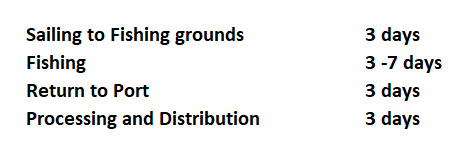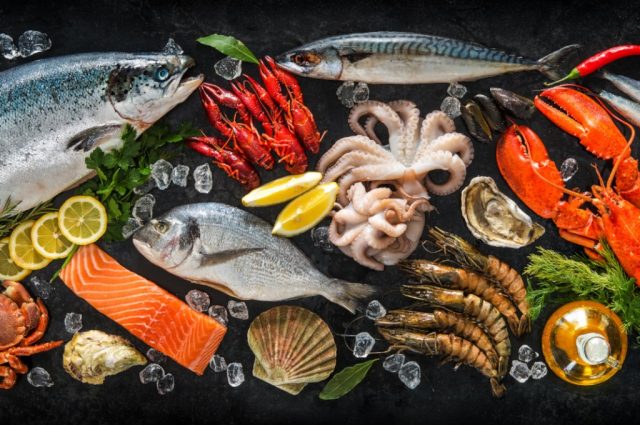Freezing fish and other seafood “stops the clock” on the processes that cause them to go off. This can mean that the freshest fish you’ll ever buy will be frozen.
While this article mainly talks about Fish it applies equally to any kind of seafood.
If you’re lucky enough to live near a harbour with day fishing boats, you’ll be able to buy fish straight from the sea. It doesn’t get better than that.
The next best option is to use one of the overnight aggregators like Pesky fish. They’ll source your order from different day boats and courier it to you overnight. You’ll get a single delivery and just one delivery fee (Pesky charge £7.99 or deliver free if your order comes to more than £40.00).
The downside of both of the above is that supply is limited and you’ll have to take what they’ve got. And often they won’t have the variety or quantity you’re after.
If you can’t get the seafood you want from the day fisherman you may be tempted to buy from your supermarket. Be careful because their idea of “fresh” is probably very different from yours and mine.
The industrial fishing supply chain for fresh fish works something like this:

This means the fresh fish in your supermarket could be at least 14 days old when you buy it and even in the best case it could be 8 days old.
Flash Freezing Seafood within hours of it being caught keeps it super fresh
Once a fish is caught bacteria causes it to decompose. Flash freezing immediately stops this process. You could argue that a fish frozen within 4 hours of being caught is fresher than a 24 hour old day boat caught fish.
Flash freezing was invented in 1924 by Clarence Birdseye. He used the technique to quickly freeze foods at extremely low temperatures (-40 degrees centigrade) without compromising freshness or flavour. These days we use liquid nitrogen to freeze fish at temperatures as low as -195 degrees centigrade.
When fish is frozen, ice crystals form inside the cells. If they’re too big they damage the cell walls giving the thawed fish an unpleasant mushy texture.
Flash freezing makes these crystals so small that they don’t damage the cells and the texture is indistinguishable from fresh.
The best frozen fish is frozen at sea as soon as it’s caught, but it’s common for processors to carry out the freezing on shore, this isn’t quite so good because the fish could already be quite old unless it’s from day fishing boats.
Chilled fish could be thawed out frozen fish
Chilled fish is often frozen fish which has been defrosted and is then distributed through the chilled food chain. Sometimes it’s thawed out in the store. My experience is that it’s rarely marked as frozen/defrosted and you might think you’re buying fresh fish.
You’re better off buying frozen fish and defrosting it yourself. The way the fish is thawed can impact the taste and texture so it’s worth a little effort to do it right.
Frozen fish helps prevent food waste
Fish has a pretty short shelf life so you need to eat it within a few days of buying it. If you can’t use it in time then you’ll have to throw it away.
When you have a pack of frozen fish in your freezer you can just thaw out exactly what you need for the next day’s meal making it zero waste.
Does freezing alter the flavor or texture of fish?
When properly stored, seafood that has been flash-frozen within hours of being caught is virtually indistinguishable from fresh seafood, offering the same flavour and texture.
Jane Brody, longtime food/nutrition columnist for The New York Times says, “The freshest seafood is that which has been frozen shortly after harvest and remains that way until cooked.”
Frozen fish must be stored properly at 0°C or below and not in a “self-defrosting” freezer because Self-defrosting freezers go through a regular thawing/freezing cycle that rapidly degrades the quality and flavour of frozen seafood..
You do need to be careful when buying frozen fish to make sure an unscrupulous supplier hasn’t frozen their unsold stock before it finally goes off. (check your suppliers reputation on Google or Trustpilot).
How to defrost frozen fish for best results
Thawing fish in the refrigerator is the best way to preserve its taste and texture.
Make sure the fish you’re thawing is in good condition and that it’s completely frozen and not partially thawed.
If the bag is unopened make sure there are no ice crystals or frost inside covering the fish. These could indicate that it’s been in storage for a long time, and may not be good to eat.
Put the fish in a bowl in the refrigerator the day before you want to use it. (There’ll be a lot of water released as it thaws).
Once thawed, check the fish is soft throughout. It should have the same texture and smell as fresh fish. If it smells too fishy or decayed, it’s no longer usable. Thawed fish may have a slightly fishy smell, but it shouldn’t be off-putting.
When using this method to thaw vacuum packaged fish, make sure to remove or open the packaging before leaving the fish in the refrigerator. Not doing so can lead to development of toxin producing bacteria
Quickly Thaw Frozen fish in water
If you’re in a rush you can defrost the fish in a bowl of water in just a few hours.
Place the fish in a plastic bag and tie the bag in a knot to completely seal it. You don’t want the water to actually touch the fish. The cool temperature of the water will be able to thaw the fish through the bag.
Place the fish in a pot of cold water. If the fish floats, put a plate or another weight on top to keep it completely submerged. The fish will thaw quickly in the cold water. Let it sit for about an hour to make sure it thaws completely.
Check the fish to see whether it has completely defrosted by pressing your finger against the flesh. If it still feels frozen in the middle, let it continue to thaw.
Don’t thaw fish in hot water because this will thaw the fish unevenly and too quickly, changing its taste and texture. Thawing in hot water will also make the outer edges susceptible to getting contaminated with bacteria before the inside of the fish is finished thawing.

